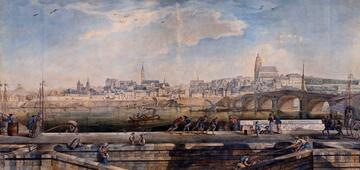
25/04/2024
[Fr] Portraits de Loire au XVIIIe siècle
À partir de documents d'époque, la websérie “Portraits de Loire au XVIIIe siècle” plonge dans cette période de l'histoire, parcourt le paysage...
Published on 31 July 2012 - Updated 03 September 2012
Cet article date d'il y a plus de 11 ans
Meeting in Saint Petersburg (Russia) from 24 June to 6 July 2012, The World Heritage Committee added 20 cultural sites, 5 natural sites and 1 mixed site to the World Heritage list. The Nord-Pas de Calais Mining Basin became France’s 38th listed site.
Nord-Pas de Calais boasts a remarkable landscape shaped by three centuries (18th to 20th century) of coal mining. The site’s 120,000 hectares are made up of 109 individual components, including pits (the oldest dating back to 1850), pit-head frames (supporting the lifts), slag heaps (some of which cover 90 hectares and are over 140 metres high), coal transport infrastructures, railway stations, mining cottages, and mining villages including schools, religious buildings, community and health facilities, town halls, mining company offices and managers’ and owners’ residences.
The site bears witness to the quest for the ideal workers’ housing estate from the mid-19th century up to the 1960s, and illustrates a significant period in Europe’s industrial history, providing a wealth of information on miners’ living conditions and worker solidarity.
Taking a look at the 20 new cultural sites on the list, it is clear that the notion of cultural landscape is still very much in use to describe the areas in question. This year, alongside the mining basin, new additions include Rio de Janeiro: Carioca landscapes between mountain and sea (Brazil), the Grand Pré landscape (Canada), the cultural landscape of Bali province: the Subak system as a manifestation of the Tri Hita Karana philosophy (Indonesia), and Bassari Country: Bassari, Peul and Bedik cultural landscapes (Senegal).
Several sites were added to the list of World Heritage in Danger, including Jesus’ birthplace: the Church of the Nativity and the Pilgrim’s Road, Bethlehem (Palestine), which was added direct to the list. The fortifications on Panama’s Caribbean coast: Portobelo-San Lorenzo and two of Mali’s World Heritage sites: Timbuktu and the Tomb of the Askias were also added, along with Liverpool Maritime Mercantile City (United Kingdom) – the latter inclusion being due to the Liverpool Waters construction project, a large-scale development of the historic quays north of the city centre.
On the other hand, the World Heritage Committee decided on the removal of two sites from the World Heritage in Danger list owing to their good state of conservation: the Fort and Shalimar Gardens in Lahore (Pakistan) and the rice-terraces of the Philippine Cordilleras.
The UNESCO World Heritage list now numbers 962 sites. With the addition of sites in the Congo, Palau, Palestine and Chad in 2012, a total of 157 countries now contain sites included on the list.
Bien reçu !
Nous vous répondrons prochainement.
L’équipe de la Mission Val de Loire.